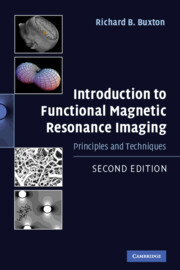
-
Select format
-
- Publisher:
- Cambridge University Press
- Publication date:
- 06 July 2010
- 27 August 2009
- ISBN:
- 9780511605505
- 9780521899956
- Dimensions:
- (247 x 174 mm)
- Weight & Pages:
- 0.92kg, 470 Pages
- Dimensions:
- Weight & Pages:
You may already have access via personal or institutional login
Book description
Functional Magnetic Resonance Imaging (fMRI) has become a standard tool for mapping the working brain's activation patterns, both in health and in disease. It is an interdisciplinary field and crosses the borders of neuroscience, psychology, psychiatry, radiology, mathematics, physics and engineering. Developments in techniques, procedures and our understanding of this field are expanding rapidly. In this second edition of Introduction to Functional Magnetic Resonance Imaging, Richard Buxton – a leading authority on fMRI – provides an invaluable guide to how fMRI works, from introducing the basic ideas and principles to the underlying physics and physiology. He covers the relationship between fMRI and other imaging techniques and includes a guide to the statistical analysis of fMRI data. This book will be useful both to the experienced radiographer, and the clinician or researcher with no previous knowledge of the technology.
Reviews
'In this extensive book on the subject by Richard B. Buxton, a physicist by background and a leading authority on fMRI, you - the student, resident, or fellow in neuroimaging, or even the clinician, researcher or experienced neuroscientist - can study, understand a lot of neurological processes … The information in the chapters of this book is presented with a lot of visuals to facilitate your understanding of the various complex topics.'
Source: Biz India
Contents
Metrics
Altmetric attention score
Full text views
Full text views help Loading metrics...
Loading metrics...
* Views captured on Cambridge Core between #date#. This data will be updated every 24 hours.
Usage data cannot currently be displayed.
Accessibility standard: Unknown
Why this information is here
This section outlines the accessibility features of this content - including support for screen readers, full keyboard navigation and high-contrast display options. This may not be relevant for you.
Accessibility Information
Accessibility compliance for the PDF of this book is currently unknown and may be updated in the future.


